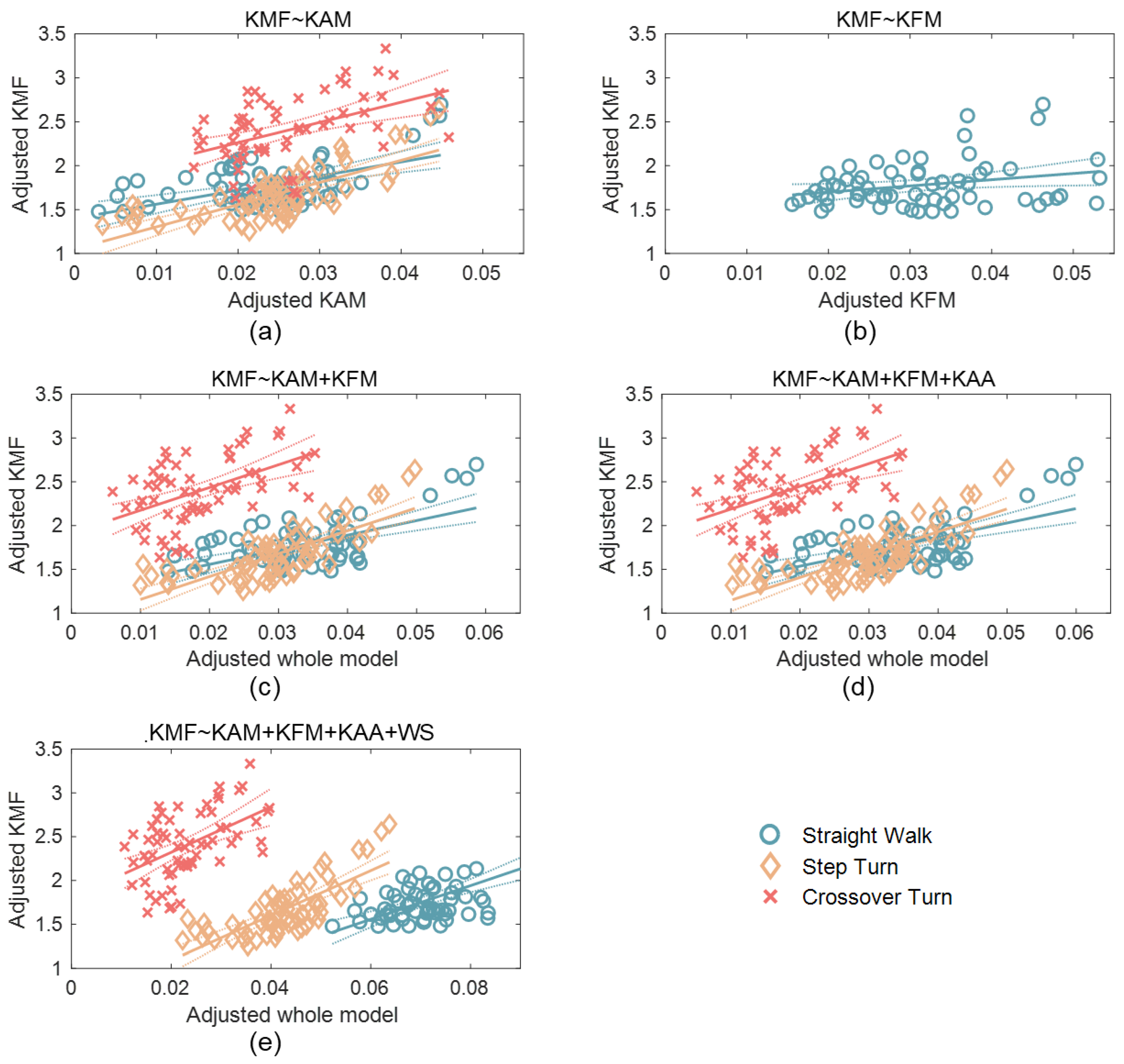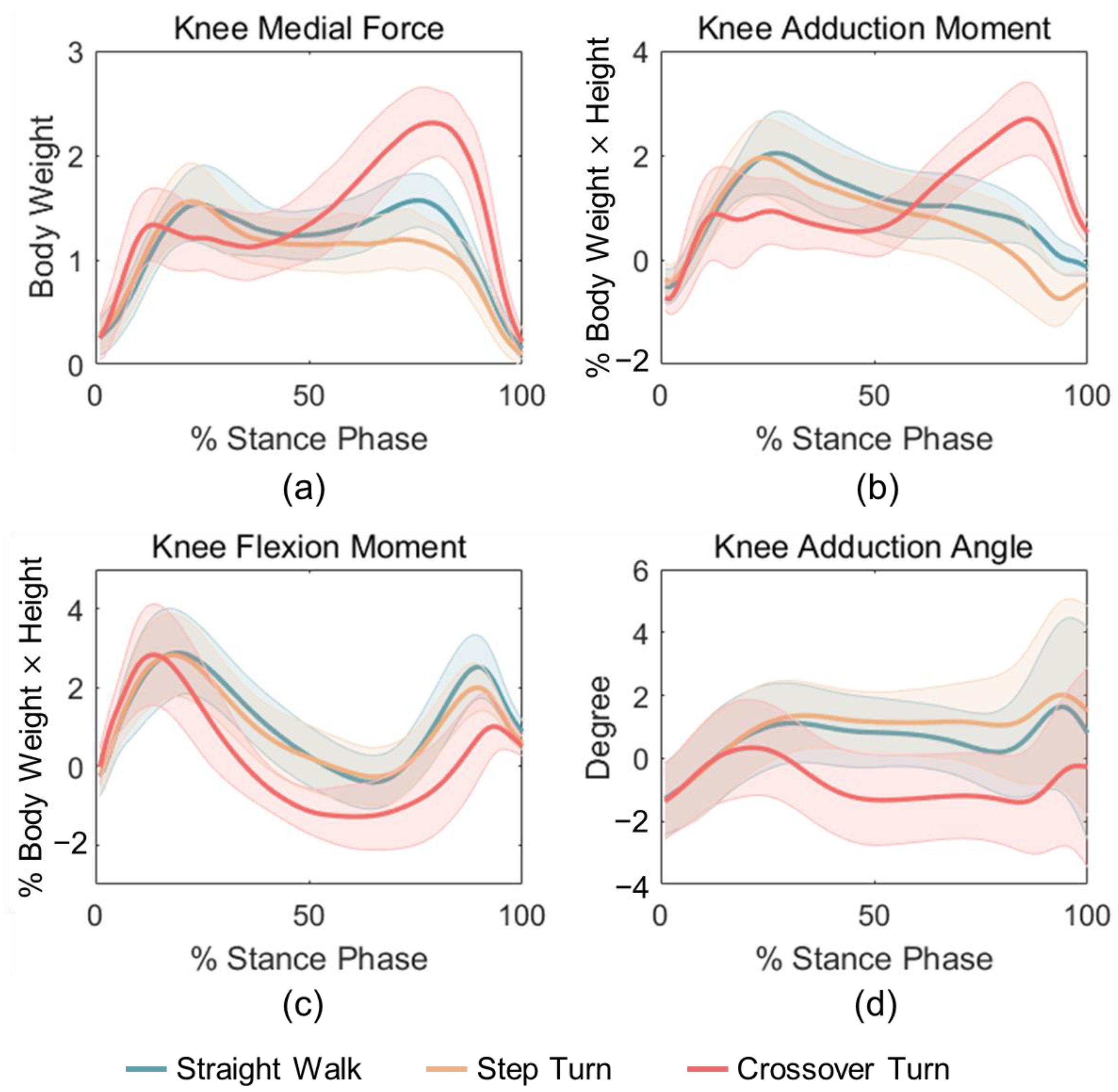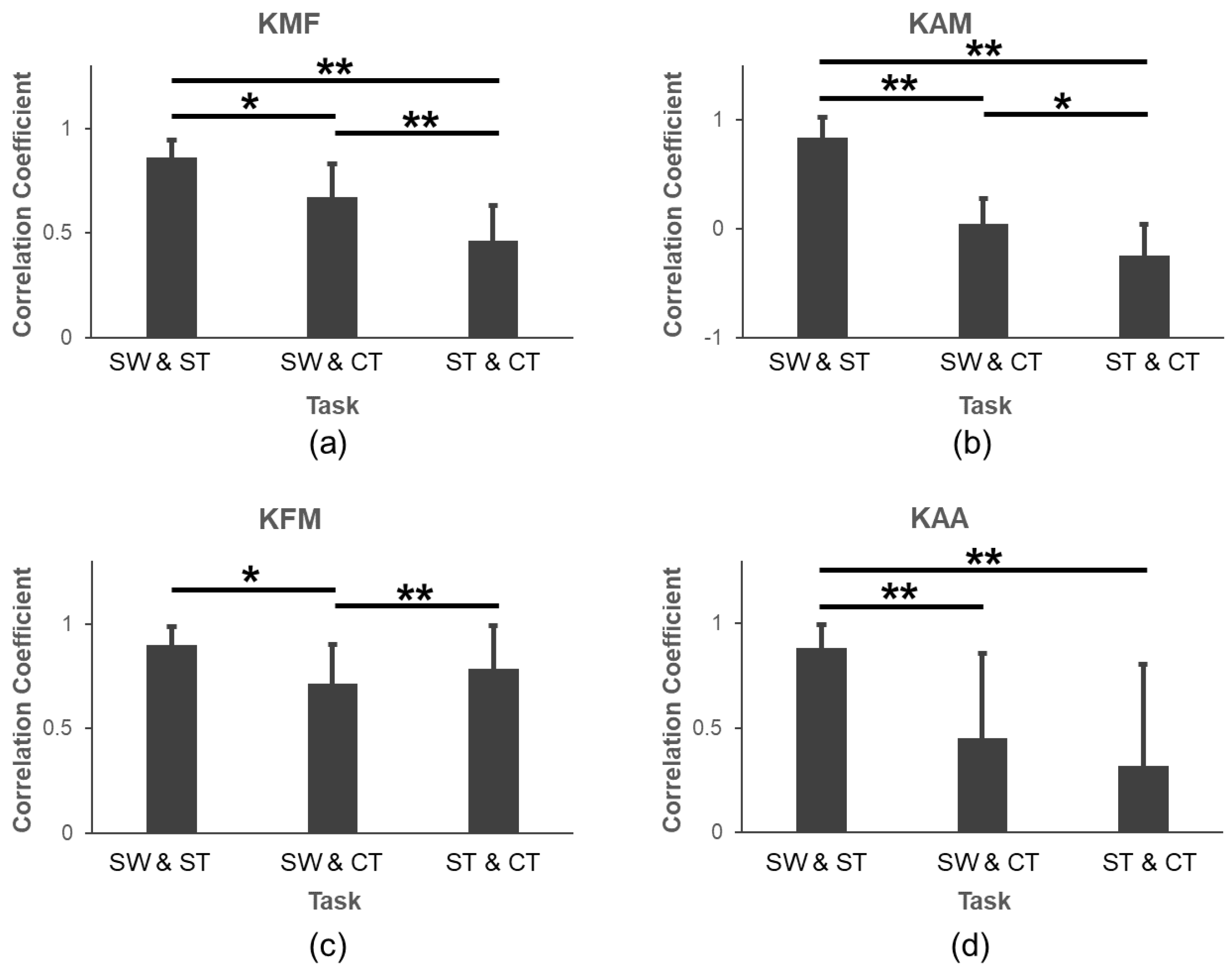The Estimation of Knee Medial Force with Substitution Parameters during Walking and Turning †
Abstract
:1. Introduction
2. Materials and Methods
2.1. Participants
2.2. Experimental Protocols
2.3. Data Processing
2.4. Statistical Analysis
3. Results
3.1. Walking Speed
3.2. pKMF Evaluation with pKAM, pKFM, pKAA, and WS
3.3. Knee Parameters of Different Level Walking Tasks
4. Discussion
5. Conclusions
Author Contributions
Funding
Institutional Review Board Statement
Informed Consent Statement
Data Availability Statement
Acknowledgments
Conflicts of Interest
References
- Egloff, C.; Hugle, T.; Valderrabano, V. Biomechanics and pathomechanisms of osteoarthritis. Swiss Med. Wkly. 2012, 142, w13583. [Google Scholar] [CrossRef]
- Vannini, F.; Spalding, T.; Andriolo, L.; Berruto, M.; Denti, M.; Espregueira-Mendes, J.; Menetrey, J.; Peretti, G.; Seil, R.; Filardo, G. Sport and early osteoarthritis: The role of sport in aetiology, progression and treatment of knee osteoarthritis. Knee Surg. Sports Traumatol. Arthrosc. 2016, 24, 1786–1796. [Google Scholar] [CrossRef] [PubMed]
- Dillon, C.F.; Rasch, E.K.; Gu, Q.; Hirsch, R. Prevalence of knee osteoarthritis in the United States: Arthritis data from the Third National Health and Nutrition Examination Survey 1991–1994. J. Rheumatol. 2006, 33, 2271–2279. [Google Scholar]
- Chang, A.; Moisio, K.; Chmiel, J.; Eckstein, F.; Guermazi, A.; Prasad, P.; Zhang, Y.; Almagor, O.; Belisle, L.; Hayes, K.; et al. External knee adduction and flexion moments during gait and medial tibiofemoral disease progression in knee osteoarthritis. Osteoarthr. Cartil. 2015, 23, 1099–1106. [Google Scholar] [CrossRef]
- Teoli, A.; Cloutier-Gendron, M.; Ho, S.Y.K.; Gu, S.; Pelletier, J.; Martel-Pelletier, J.; Robbins, S.M. The relationship between knee loading during gait and cartilage thickness in nontraumatic and posttraumatic knee osteoarthritis. J. Orthop. Res. 2022, 40, 1778–1786. [Google Scholar] [CrossRef]
- Holder, J.; Feja, Z.; van Drongelen, S.; Adolf, S.; Böhm, H.; Meurer, A.; Stief, F. Effect of guided growth intervention on static leg alignment and dynamic knee contact forces during gait. Gait Posture 2020, 78, 80–88. [Google Scholar] [CrossRef] [PubMed]
- Rane, L.; Bull, A.M. Functional electrical stimulation of gluteus medius reduces the medial joint reaction force of the knee during level walking. Arthritis Res. Ther. 2016, 18, 255. [Google Scholar] [CrossRef]
- Fregly, B.J.; Reinbolt, J.A.; Rooney, K.L.; Mitchell, K.H.; Chmielewski, T.L. Design of patient-specific gait modifications for knee osteoarthritis rehabilitation. IEEE Trans. Biomed. Eng. 2007, 54, 1687–1695. [Google Scholar] [CrossRef]
- Kinney, A.L.; Besier, T.F.; Silder, A.; Delp, S.L.; D’Lima, D.D.; Fregly, B.J. Changes in in vivo knee contact forces through gait modification. J. Orthop. Res. 2013, 31, 434–440. [Google Scholar] [CrossRef] [PubMed]
- Shu, L.; Yamamoto, K.; Yoshizaki, R.; Yao, J.; Sato, T.; Sugita, N. Multiscale finite element musculoskeletal model for intact knee dynamics. Comput. Biol. Med. 2022, 141, 105023. [Google Scholar] [CrossRef]
- Serrancolí, G.; Kinney, A.L.; Fregly, B.J. Influence of musculoskeletal model parameter values on prediction of accurate knee contact forces during walking. Med. Eng. Phys. 2020, 85, 35–47. [Google Scholar] [CrossRef] [PubMed]
- Bowd, J.; Van Rossom, S.; Williams, D.; Elson, D.; Wilson, C.; Whatling, G.; Holt, C.; Jonkers, I. Using musculoskeletal modelling to estimate knee joint loading pre and post high tibial osteotomy. Clin. Biomech. 2023, 101, 105855. [Google Scholar] [CrossRef]
- Frigo, C.A.; Donno, L. The Effects of External Loads and Muscle Forces on the Knee Joint Ligaments during Walking: A Musculoskeletal Model Study. Appl. Sci. 2021, 11, 2356. [Google Scholar] [CrossRef]
- Schipplein, O.D.; Andriacchi, T.P. Interaction between active and passive knee stabilizers during level walking. J. Orthop. Res. 1991, 9, 113–119. [Google Scholar] [CrossRef] [PubMed]
- Zhao, D.; Banks, S.A.; Mitchell, K.H.; D’Lima, D.D.; Colwell, C.W., Jr.; Fregly, B.J. Correlation between the knee adduction torque and medial contact force for a variety of gait patterns. J. Orthop. Res. 2007, 25, 789–797. [Google Scholar] [CrossRef]
- De Pieri, E.; Nüesch, C.; Pagenstert, G.; Viehweger, E.; Egloff, C.; Mündermann, A. High tibial osteotomy effectively redistributes compressive knee loads during walking. J. Orthop. Res. 2023, 41, 591–600. [Google Scholar] [CrossRef] [PubMed]
- Walter, J.P.; D’Lima, D.D.; Colwell, C.W., Jr.; Fregly, B.J. Decreased knee adduction moment does not guarantee decreased medial contact force during gait. J. Orthop. Res. 2010, 28, 1348–1354. [Google Scholar] [CrossRef] [PubMed]
- Zeighami, A.; Dumas, R.; Aissaoui, R. Knee loading in OA subjects is correlated to flexion and adduction moments and to contact point locations. Sci. Rep. 2021, 11, 8594. [Google Scholar] [CrossRef] [PubMed]
- Ogaya, S.; Naito, H.; Iwata, A.; Higuchi, Y.; Fuchioka, S.; Tanaka, M. Knee adduction moment and medial knee contact force during gait in older people. Gait Posture 2014, 40, 341–345. [Google Scholar] [CrossRef]
- Richards, R.E.; Andersen, M.S.; Harlaar, J.; Van Den Noort, J.C. Relationship between knee joint contact forces and external knee joint moments in patients with medial knee osteoarthritis: Effects of gait modifications. Osteoarthr. Cartil. 2018, 26, 1203–1214. [Google Scholar] [CrossRef]
- Holder, J.; van Drongelen, S.; Uhlrich, S.D.; Herrmann, E.; Meurer, A.; Stief, F. Peak knee joint moments accurately predict medial and lateral knee contact forces in patients with valgus malalignment. Sci. Rep. 2023, 13, 2870. [Google Scholar] [CrossRef]
- Manal, K.; Gardinier, E.; Buchanan, T.; Snyder-Mackler, L. A more informed evaluation of medial compartment loading: The combined use of the knee adduction and flexor moments. Osteoarthr. Cartil. 2015, 23, 1107–1111. [Google Scholar] [CrossRef] [PubMed]
- Marouane, H.; Shirazi-Adl, A. Sensitivity of medial-lateral load sharing to changes in adduction moments or angles in an asymptomatic knee joint model during gait. Gait Posture 2019, 70, 39–47. [Google Scholar] [CrossRef] [PubMed]
- Glaister, B.C.; Bernatz, G.C.; Klute, G.K.; Orendurff, M.S. Video task analysis of turning during activities of daily living. Gait Posture 2007, 25, 289–294. [Google Scholar] [CrossRef] [PubMed]
- Loi, I.; Zacharaki, E.I.; Moustakas, K. Multi-Action. Knee Contact Force Prediction by Domain Adaptation. IEEE Trans. Neural Syst. Rehabil. Eng. 2024, 32, 122–132. [Google Scholar] [CrossRef]
- Valente, G.; Grenno, G.; Fabbro, G.D.; Zaffagnini, S.; Taddei, F. Medial and lateral knee contact forces during walking, stair ascent and stair descent are more affected by contact locations than tibiofemoral alignment in knee osteoarthritis patients with varus malalignment. Front. Bioeng. Biotechnol. 2023, 11, 1254661. [Google Scholar] [CrossRef]
- Winter, D.A. Biomechanics and Motor Control of Human Movement, 4th ed.; John Wiley & Sons, Inc.: Toronto, ON, Canada, 2004. [Google Scholar]
- Cleather, D.J.; Bull, A.M.J. The development of a segment-based musculoskeletal model of the lower limb: Introducing FREEBODY. R. Soc. Open Sci. 2015, 2, 140449. [Google Scholar] [CrossRef]
- Ding, Z.; Nolte, D.; Tsang, C.K.; Cleather, D.J.; Kedgley, A.E.; Bull, A.M.J. In Vivo Knee Contact Force Prediction Using Patient-Specific Musculoskeletal Geometry in a Segment-Based Computational Model. J. Biomech. Eng. 2016, 138, 021018. [Google Scholar] [CrossRef]
- Adouni, M.; Shirazi-Adl, A. Partitioning of knee joint internal forces in gait is dictated by the knee adduction angle and not by the knee adduction moment. J. Biomech. 2014, 47, 1696–1703. [Google Scholar] [CrossRef]
- Creaby, M.W.; Wang, Y.; Bennell, K.L.; Hinman, R.S.; Metcalf, B.R.; Bowles, K.A.; Cicuttini, F.M. Dynamic knee loading is related to cartilage defects and tibial plateau bone area in medial knee osteoarthritis. Osteoarthr. Cartil. 2010, 18, 1380–1385. [Google Scholar] [CrossRef]
- Taylor, M.; Dabnichki, P.; Strike, S. A three-dimensional biomechanical comparison between turning strategies during the stance phase of walking. Hum. Mov. Sci. 2005, 24, 558–573. [Google Scholar] [CrossRef] [PubMed]
- Zhao, D.; Banks, S.A.; D’Lima, D.D.; Colwell, C.W.; Fregly, B.J. In vivo medial and lateral tibial loads during dynamic and high flexion activities. J. Orthop. Res. 2007, 25, 593–602. [Google Scholar] [CrossRef]
- Guo, M.; Axe, M.J.; Manal, K. The influence of foot progression angle on the knee adduction moment during walking and stair climbing in pain free individuals with knee osteoarthritis. Gait Posture 2007, 26, 436–441. [Google Scholar] [CrossRef] [PubMed]
- Kutzner, I.; Trepczynski, A.; Heller, M.O.; Bergmann, G. Knee adduction moment and medial contact force—Facts about their correlation during gait. PLoS ONE 2013, 8, e81036. [Google Scholar] [CrossRef] [PubMed]
- Sharma, L.; Hurwitz, D.E.; Thonar, E.J.-M.A.; Sum, J.A.; Lenz, M.E.; Dunlop, D.D.; Schnitzer, T.J.; Kirwan-Mellis, G.; Andriacchi, T.P. Knee adduction moment, serum hyaluronan level, and disease severity in medial tibiofemoral osteoarthritis. Arthritis Rheum. 1998, 41, 1233–1240. [Google Scholar] [CrossRef]
- Ibara, T.; Hada, K.; Karashima, R.; Kawashima, M.; Anan, M. Correlation between rotational moments of the knee and other joints during gait, including the free moment of patients with a medial meniscus tear. Acta Bioeng. Biomech. 2022, 24, 119–126. [Google Scholar] [CrossRef]





| Task | Predictors | Model | Beta Coefficients | R2 (Adj. R2) | Sig. | ||||
|---|---|---|---|---|---|---|---|---|---|
| Unstandardized | Std. Error | Standardized | t | Sig. | |||||
| Straight walk | pKAM | Const | 1.402 | 0.081 | 17.268 | <0.001 | 0.284 (0.273) | <0.001 | |
| pKAM | 16.042 | 3.232 | 0.533 | 4.963 | <0.001 | ||||
| pKFM | Const | 1.557 | 0.107 | 14.502 | <0.001 | 0.071 (0.055) | 0.034 | ||
| pKFM | 7.090 | 3.269 | 0.266 | 2.169 | 0.034 | ||||
| pKAM pKFM | Const | 1.222 | 0.115 | 10.731 | <0.001 | 0.336 (0.314) | <0.001 | ||
| pKAM | 15.545 | 3.154 | 0.517 | 4.941 | <0.001 | ||||
| pKFM | 6.092 | 2.830 | 0.228 | 2.181 | 0.033 | ||||
| pKAM pKFM pKAA | Const | 1.207 | 0.121 | 9.958 | <0.001 | 0.338 (0.305) | <0.001 | ||
| pKAM | 15.185 | 3.297 | 0.505 | 4.606 | <0.001 | ||||
| pKFM | 6.348 | 2.886 | 0.238 | 2.200 | 0.032 | ||||
| pKAA | 0.006 | 0.015 | 0.044 | 0.396 | 0.694 | ||||
| pKAM pKFM pKAA WS | Const | 0.404 | 0.398 | 1.016 | 0.314 | 0.384 (0.343) | <0.001 | ||
| pKAM | 19.126 | 3.710 | 0.636 | 5.156 | <0.001 | ||||
| pKFM | 4.645 | 3.583 | 0.062 | 0.459 | 0.648 | ||||
| pKAA | −0.005 | 0.016 | −0.039 | −0.340 | 0.735 | ||||
| WS | 0.881 | 0.417 | 0.295 | 2.111 | 0.039 | ||||
| Step turn | pKAM | Const | 1.052 | 0.077 | 13.654 | <0.001 | 0.538 (0.530) | <0.001 | |
| pKAM | 25.248 | 2.974 | 0.733 | 8.489 | <0.001 | ||||
| pKAM pKFM | Const | 0.894 | 0.113 | 7.896 | <0.001 | 0.563 (0.548) | <0.001 | ||
| pKAM | 25.671 | 2.925 | 0.746 | 8.778 | <0.001 | ||||
| pKFM | 5.183 | 2.764 | 0.159 | 1.875 | 0.066 | ||||
| pKAM pKFM pKAA | Const | 0.885 | 0.119 | 7.471 | <0.001 | 0.563 (0.541) | <0.001 | ||
| pKAM | 25.572 | 2.972 | 0.743 | 8.604 | <0.001 | ||||
| pKFM | 5.251 | 2.798 | 0.161 | 1.877 | 0.065 | ||||
| pKAA | 0.003 | 0.011 | 0.022 | 0.258 | 0.797 | ||||
| pKAM pKFM pKAA WS | Const | 0.580 | 0.273 | 2.126 | 0.038 | 0.574 (0.545) | <0.001 | ||
| pKAM | 25.399 | 2.962 | 0.738 | 8.574 | <0.001 | ||||
| pKFM | 2.758 | 3.435 | 0.085 | 0.803 | 0.425 | ||||
| pKAA | 0.001 | 0.011 | 0.011 | 0.131 | 0.896 | ||||
| WS | 0.395 | 0.318 | 0.130 | 1.240 | 0.220 | ||||
| Crossover turn | pKAM | Const | 1.803 | 0.152 | 11.825 | <0.001 | 0.215 (0.203) | <0.001 | |
| pKAM | 23.002 | 5.576 | 0.464 | 4.125 | <0.001 | ||||
| pKAM pKFM | Const | 1.915 | 0.163 | 11.748 | <0.001 | 0.253 (0.228) | <0.001 | ||
| pKAM | 25.391 | 5.653 | 0.512 | 4.492 | <0.001 | ||||
| pKFM | −5.623 | 3.211 | −0.200 | −1.751 | 0.085 | ||||
| pKAM pKFM pKAA | Const | 1.929 | 0.170 | 11.328 | <0.001 | 0.254 (0.217) | <0.001 | ||
| pKAM | 25.342 | 5.697 | 0.521 | 4.448 | <0.001 | ||||
| pKFM | −5.751 | 3.261 | −0.204 | −1.764 | 0.083 | ||||
| pKAA | −0.008 | 0.024 | −0.035 | −0.313 | 0.756 | ||||
| pKAM pKFM pKAA WS | Const | 1.805 | 0.429 | 4.208 | <0.001 | 0.255 (0.205) | 0.001 | ||
| pKAM | 25.167 | 5.767 | 0.508 | 4.364 | <0.001 | ||||
| pKFM | −5.969 | 3.358 | −0.212 | −1.778 | 0.081 | ||||
| pKAA | −0.007 | 0.024 | −0.035 | −0.304 | 0.762 | ||||
| WS | 0.442 | 0.442 | 0.037 | 0.315 | 0.754 | ||||
Disclaimer/Publisher’s Note: The statements, opinions and data contained in all publications are solely those of the individual author(s) and contributor(s) and not of MDPI and/or the editor(s). MDPI and/or the editor(s) disclaim responsibility for any injury to people or property resulting from any ideas, methods, instructions or products referred to in the content. |
© 2024 by the authors. Licensee MDPI, Basel, Switzerland. This article is an open access article distributed under the terms and conditions of the Creative Commons Attribution (CC BY) license (https://creativecommons.org/licenses/by/4.0/).
Share and Cite
Liu, S.; Wang, Z.; Chen, J.; Xu, R.; Ming, D. The Estimation of Knee Medial Force with Substitution Parameters during Walking and Turning. Sensors 2024, 24, 5595. https://doi.org/10.3390/s24175595
Liu S, Wang Z, Chen J, Xu R, Ming D. The Estimation of Knee Medial Force with Substitution Parameters during Walking and Turning. Sensors. 2024; 24(17):5595. https://doi.org/10.3390/s24175595
Chicago/Turabian StyleLiu, Shizhong, Ziyao Wang, Jingwen Chen, Rui Xu, and Dong Ming. 2024. "The Estimation of Knee Medial Force with Substitution Parameters during Walking and Turning" Sensors 24, no. 17: 5595. https://doi.org/10.3390/s24175595






